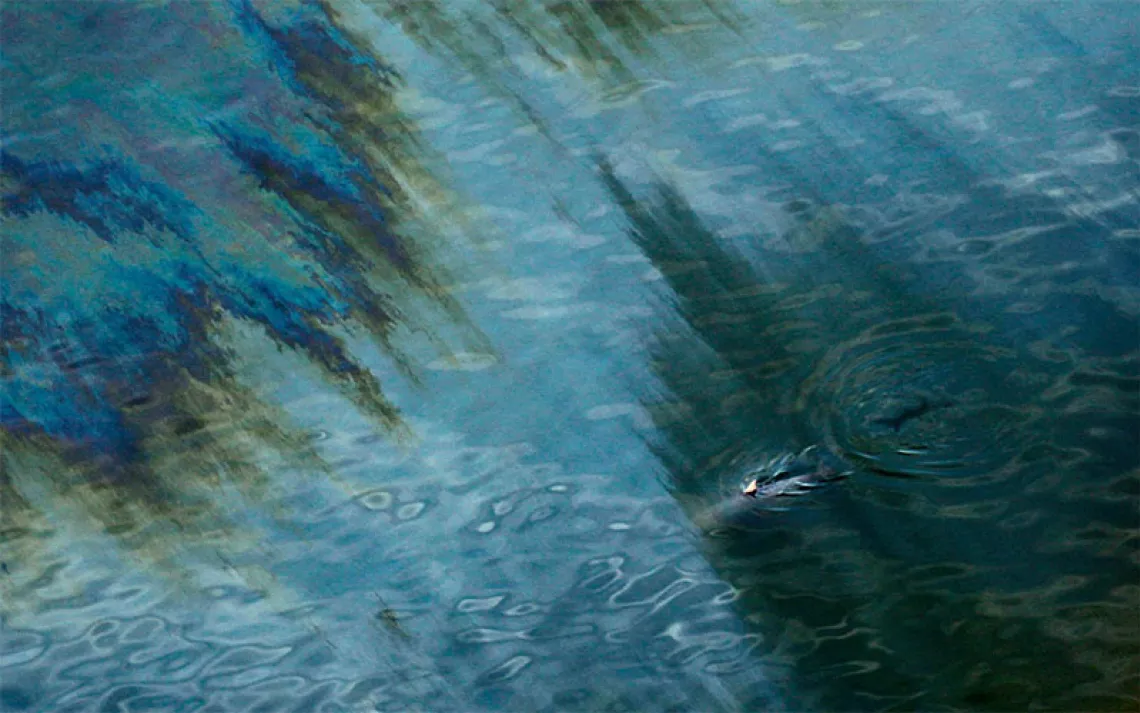Robots to the Rescue on the Great Barrier Reef
In a pilot project starting this week, robots deliver millions of “baby corals”

Courtesy of Great Barrier Reef Foundation
Last Tuesday night in Australia, a magic coalescence of full moon tides and just-right sea temperatures triggered a supernatural event on the Great Barrier Reef. Corals of all varieties began releasing their eggs and sperm in a mass synchronized spawning that’s withstood waves of evolution. The annual phenomenon, which only happens at night, resembles an underwater blizzard in which billions of white, yellow, and pink spawn bundles float to the surface like glitter in a snow globe. Fertilization ensues, and five to seven days later, new coral larvae are ready to restock the reef.
At least that’s what happens on healthy parts of the Great Barrier Reef. Back-to-back heat waves in 2016 and 2017 killed off half the reef’s remaining coral (and spawning capacity) through a process known as bleaching. When corals are overheated, they eject the symbiotic algae that gives them their life and color, transforming once-vibrant reefs into boneyards of coral. Given the frailty of the reef and ever more bleaching on the horizon due to climate change, this year’s coral spawn is more important—and consequential—than ever. That’s why Southern Cross University ecologist Dr. Peter Harrison and Queensland University of Technology engineer Dr. Matthew Dunbabin are joining forces to give nature a robotic helping hand.

Heron Island 2017 coral spawn | Courtesy of Gary Cranitch
“On healthy reefs, you would never bother intervening because the reef is doing a fantastic job restoring itself,” says Harrison, whose pioneering research in “larval reseeding,” or “coral IVF,” has set the stage for the current restoration. But on the Great Barrier Reef, and on most reefs around the world, sexually reproductive corals are dwindling. “If we don’t [intervene], there simply won’t be enough larvae naturally produced to enable recovery,” Harrison adds.
With that reality in mind, researchers have been working fast to harvest millions of coral eggs and sperm released at Moore Reef, a healthier system located an hour and a half by boat from Cairns. Once collected, the spawn bundles are transferred from giant nets to floating reef enclosures as large as swimming pools, where embryos are reared into larvae, or “baby corals.” This week, when the larvae are mature enough to resettle, they’ll get loaded into autonomous underwater vehicles (AUVs) developed by Dunbabin, then sprinkled onto damaged reefs nearby at the touch of a button.

LarvalBot adaptation of RangerBot | Courtesy of Matthew Dunbabin
Not only is this the largest coral regeneration project ever attempted, it’ll employ spawn from thermally tolerant corals that survived the past two bleaching events, the thought being that they are better suited for future warming. It also draws on robotics—for the first time ever—to rapidly target and repopulate degraded reef sites and expand the size of potential restoration zones. Results from small-scale studies show that corals can reestablish themselves within two to three years, even on reefs that were considered dead zones. Ultimately, conservationists need to scale up dramatically to make a real difference, and robotics could provide the extra eyes, hands, and speed to get there.
“That’s what’s really exciting about this project,” Harrison says. “It combines ecology with technology and enables us to be thinking about very large-scale coral restoration into the future. If we can start to recover some essential coral communities on damaged reef systems at square-kilometer scale, we can have a real impact in re-establishing reefs very quickly.”

Peter Harrison | Courtesy of Gary Cranitch
While Harrison has been busy performing coral IVF inside the lab and out on the reef, Dunbabin has been tinkering with underwater robots. In 2015, he launched COTSbot, a submarine-like AUV guided by computer vision and sonar that can detect reef-eating crown of thorns starfish (COTS) and inject them with a fatal dose of bile salts to control their numbers. Earlier this year, Dunbabin launched his follow-up RangerBot: a smaller and more affordable patrol robot, which has the same starfish-killing capacity plus new tech to monitor coral bleaching, test water quality, and map underwater areas using a $150 camera in place of a $25,000 sonar sensor.
RangerBot was designed as a commercial product with a dronelike interface, controlled by a tablet. You can set it on a path at a specific depth, and it usually swims between 1.8 kilometers (1 mile) and 3 kilometers (1.8 miles) in an hour. It has a citizen science portal to collect data that’s fed to an AI for better insights on coral, seagrass, starfish, and coral bleaching. It’s also kitted out with water-quality sensors, lights, removable batteries, and extra attachments for everything from collecting water to, now, delivering coral babies. “When we were building [RangerBot], we used to call it the Swiss Army knife—the tool that can do many things,” Dunbabin says.
While coral larvae are maturing in Harrison’s floating nurseries this week, RangerBot will be mapping the seafloor and coral cays to find suitable resettling sites around Arlington and Vlasoff Reefs—which were brilliant places off Cairns to snorkel and dive before they got squelched by last year’s bleaching. Once the larvae are ready to recolonize, a high concentration will be sieved into a balloon-like bladder, which attaches to the underside of RangerBot, transforming it into LarvalBot. When the robot arrives at a suitable reef site, a researcher monitoring from above water will press a button to spurt out the larvae.
“Imagine a little cloud of smoke coming out the back,” Dunbabin says. “That’s the larvae being pushed out by the robot as it [swims] over. It’s basically like spreading fertilizer on your lawn very gently.”
While the robots carry out their missions, Harrison’s team will be trialing other methods of larval dispersal to figure out what yields the highest rate of resettlement. Colleagues such as Katie Chartrand from James Cook University and David Suggett from University of Technology Sydney will also play matchmaker inside the lab, pairing different types of coral larvae with an equal variety of symbiotic algal partners, or symbiodinium, which corals need to survive, and then putting those back on the reef for testing. Over the coming months and years, the new coral colonies will be checked periodically by researchers and RangerBots to measure success.

Larval reseeding on Heron Island in 2017 | Courtesy of Gary Cranitch
There’s certainly no time to waste. The International Panel on Climate Change (IPCC) just released a report predicting that coral reefs will decline by 70 to 90 percent by the year 2100, even if we limit global warming to 1.5°C (2.7°F)—a target that’s looking more impossible by the day. Yet, while climate action is the only way to really help coral reefs—the most biodiverse ecosystems on Earth after tropical rainforests—it’s critical to keep working to protect what’s left, says Dr. Petra Lundgren, project director for restoration, science, and innovation at the Great Barrier Reef Foundation, a partner on the coral spawning project, which was funded by a $220,000 grant from the Tiffany & Co. Foundation.

Larval reseeding in 2017 | Photo courtesy of Gary Cranitch
“We need to do everything we possibly can to retain, restore, and maintain the resilience of coral reefs right now so if we do manage to do something about climate change, there will be reefs left to repopulate what’s been lost,” she says.
Deploying LarvalBot for this year’s spawn is a good example of how diverse backgrounds and the power of technology can come together to spark solutions.
“We’ve got to at least try this technique,” Dunbabin says, “and if it’s as successful as we think it will be, then we can do some good things for reefs around the world. We can’t wait another year.”

Courtesy of the Great Barrier Reef Foundation
 The Magazine of The Sierra Club
The Magazine of The Sierra Club



